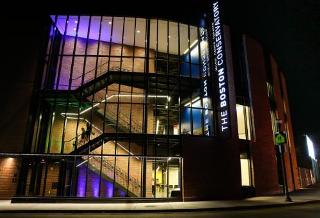Sep 25 2014
The Boston Conservatory, the oldest performing arts Conservatory of its kind in the nation, recently opened its new studio building located at 132 Ipswich Street. A collaboration between Handel Architects LLP and Utile, Inc., the team worked to design a ground-up structure to house studio practice space suited for the school's curriculum.
 132 Ipswich Street (PRNewsFoto/Utile)
132 Ipswich Street (PRNewsFoto/Utile)
The building houses a large orchestra rehearsal space, two dance studios, teaching studios, multipurpose rooms and practice rooms for the instruction of movement, voice, instrument, and orchestra ensemble.
"We designed this building to help give this nearly 150-year-old institution an even stronger presence in the city of Boston," said Blake Middleton FAIA, lead designer and a partner at Handel Architects LLP. "The brick echoes the architecture of the neighborhood, while also creating a state-of-the-art learning environment for its students and faculty. In a sense it is an 'inhabited billboard.'"
Maximizing the program space on an extremely tight budget was a challenge, and required highly efficient planning. Interaction between students and faculty, many of different disciplines, is promoted by channeling everyone through the same door and into a vertical common space, which is celebrated with a three-story open atrium. The main 3,250 square-foot orchestra rehearsal studio takes the primary position, with two dance studios above with great views of the Boston skyline and natural light. Practice rooms and teaching studios surround these on three floors.
The building is sited on tight quarters in an unorthodox location for a noise sensitive building: the Massachusetts Turnpike is nearby, as well as a commuter rail line, and Fenway Park is a block away.
"By employing 'box within a box' construction, and leveraging the density of the masonry walls, the design team was able to suppress the outside noise for those spaces that required it," said Middleton.
"The design solution was inspired by both the vitality and challenges of a site located in the heart of a major U.S. city," said Mimi Love at Utile. "We had to blend in with the urban fabric, right next to Fenway Park, while creating an iconic building that would represent the values of the school. Our team also had to find the right strategy of construction systems and materials to overcome acoustical issues from baseball games and traffic from the Massachusetts Turnpike."